Evaluation of maize inbred lines currently used in Chinese breeding programs for resistance to six foliar diseases
2014-02-28YunhuZhngXiudeXuHongjieLiXiofeiWuShihungZhngXinhiLi
*,Yunhu Zhng,Xiude Xu,Hongjie LiXiofei Wu Shihung ZhngXinhi Li
aThe National Key Facility for Crop Gene Resources and Genetic Improvement,Institute of Crop Science,Chinese Academy of AgriculturalSciences, Beijing 100081,China
bInstitute of Plant Protection,Heilongjiang Academy of Agricultural Sciences,Harbin 150086,China
cInstitute of Plant Protection,Liaoning Academy of Agricultural Sciences,Shenyang 110161,China
Evaluation of maize inbred lines currently used in Chinese breeding programs for resistance to six foliar diseases
Xiaoming Wanga,*,Yunhua Zhangb,Xiude Xuc,Hongjie Lia,Xiaofei Wua, Shihuang Zhanga,Xinhai Lia
aThe National Key Facility for Crop Gene Resources and Genetic Improvement,Institute of Crop Science,Chinese Academy of AgriculturalSciences, Beijing 100081,China
bInstitute of Plant Protection,Heilongjiang Academy of Agricultural Sciences,Harbin 150086,China
cInstitute of Plant Protection,Liaoning Academy of Agricultural Sciences,Shenyang 110161,China
A R T I C L E I N F O
Article history:
Received 21 January 2014
Received in revised form 2 April2014
Accepted 14 April2014
Available online 14 May 2014
Zea mays
Foliar diseases are common in most maize-producing regions and have caused serious yield reduction in China.To evaluate genetic resistance of parental lines actively used in maize breeding programs to major foliar diseases,152 maize inbred lines were tested against northern corn leaf blight(NCLB),southern corn leaf blight(SCLB),Curvularia leaf spot(CLS), gray leaf spot(GLS),common rust,and southern rust from 2003 to 2005.A small number of lines exhibited highly resistant reactions to common rust and southern rust,but none were highly resistant to NCLB,SCLB,CLS,and GLS.Although 53.3%,40.8%,and 80.7%of lines were resistant to NCLB,SCLB,and common rust,the resistance in most lines was moderate. Resistance to CLS,GLS,and southern rustwas rare in this collection ofmaize lines.Five lines, 313,Chang 7-2,Qi 319,Qi 318,and Shen 137,were resistant to five diseases tested.Lines belonging to heterotic subgroup PB exhibited betterresistance to the foliar diseases than lines from other heterotic subgroups,such as BSSS,PA,Lancaster,LRC,and PA.The results willbe of benefit to breeders for selecting lines in disease resistance breeding programs.
©2014 Crop Science Society of China and Institute of Crop Science,CAAS.Production and hosting by Elsevier B.V.All rights reserved.
1.Introduction
Maize(Zea mays L.)is the largest crop in China,and is grown throughout the country from the spring maize belt in northeastern region to the southwestern mountain spring maize belt. In 2012,maize was planted on 3.50 million hectares and the total production of corn was 206 million tons,accounting for 31.9%and 35.7%of the total areas and production of the cereal crops,respectively(http://data.stats.gov.cn/workspace/index; jsessionid).The average yield of maize was 5.7 tha-1.Since2000,the growing area,totalproduction and the average yield of maize have increased by 51.9%,94.0%,and 27.7%,respectively. However,the occurrence ofvarious foliar diseases has become a serious yield limiting factor in most maize producing regions throughout the country.
Northern corn leaf blight(NCLB),caused by Setosphaeria turcica(Luttrell)Leonard et Suggs,anamorph:Exserohilum turcicum(Pass.)Leonard et Suggs is one of the most harmful diseases in the spring corn regions.In the late 1980s,use of the inbred line Mo 17 originating from the USA,which carries gene Ht for resistance to NCLB,effectively controlled this disease.Recently,the outbreak of NCLB has resulted in severe yield losses in northeastern and northern China.Owing to cultivation ofresistant hybrids,the shift of E.turcicum race 0 in the 1980s to race 1 in the 1990s and the occurrence of other races have resulted in severe economic losses[1-3].Southern corn leafblight(SCLB)Cochliobolus heterostrophus(Drechs.)Drechs., anamorph:Bipolaris maydis(Nisikado et Miyake)Shoemaker is a major yield limiting disease in the summer corn regions.The predominant race of B.maydis is race O,which accounts for 79.7%ofisolates.The frequencies ofraces C,T,and S were 5.0%, 10.0%,and 5.3%,respectively[4].Although recently released commercial hybrids are effective against this disease,it is desirable to identify more resistant inbred lines from different resources with diverse resistance genes,because more virulent B.maydis races have been found in commercialfields[4].During the late 1980s,epidemics of Curvularia leaf spot(CLS)(Curvularia lunata[Wakker]Boed.)were a serious problem in maize fields in the northeastern and northern regions[5].In recent years,this disease has occurred inmaize fields allover the country and has been severe in regions such as western Liaoning province and central Jilin province when weather conditions favored disease development[6,7].Gray leaf spot(GLS)(Cercospora zeae-maydis Tehon et Daniels)occurs in spring maize growing areas,but is a major problem for maize production in Yunnan province and is widely epidemic in northeastern China including Heilongjiang province,the largest maize production area in China[8-14]. Common rust(Puccinia sorghi Schwein.)is frequently observed in the spring maize growing areas.The incidence ofthis disease is severe in certain areas,but has not resulted in serious economic loss except in Guizhou and Yunnan provinces.Prior to the 1980s,southern rust(Puccinia polysora Undrew)was one of the most important maize diseases in southeastern China,but the occurrence ofthis disease has been limited due to reduction of planting area in this region.Since 2000,southern rust has become a serious problem in the summer maize growing regions and more than 10%of yield losses have been recorded in some hybrid lines.In 2007 and 2008,the disease was observed in the northern part of the summer maize growing region including Beijing,central Hebei province,and southern Liaoning province,suggesting that southern rust will become epidemic throughout the summer maize growing region as wellas some spring maize regions.
Foliar diseases occur mainly after the tasseling stage of maize,making them difficult to controlwith fungicides in the field.Thus,improvement of genetic resistance to the foliar diseases remains an important objective in maize breeding programs.Understanding of disease reactions is essential for parental selection and resistant hybrid development,as well as for mapping resistance genes[15-18].
In the past decades,growing resistant cultivars in most maize producing regions has effectively controlled some foliar diseases.However,severe yield losses have been incurred by new races of pathogens and changes of weather and planting density.For this reason there is a need to evaluate disease resistance in parental inbred lines from various maize growing regions and to identify resistant parents for maize improvement.In 2003,a project was initiated to assess reactions to 11 major diseases of maize inbred lines that are used in current breeding programs.The objective ofthe present study was to evaluate the reactions to NCLB,SCLB,CLS,GLS, common rust,and southern rust of a collection of parental inbred lines that are actively used in most maize breeding programs or are widely grown cultivars.
2.Materials and methods
2.1.Plant materials
One hundred and fifty-two inbred lines of maize were collected from the major maize breeding programs in China and the seeds were increased at the Maize Centre,Chinese Academy of Agricultural Sciences(CAAS),Beijing,China.Based on information oftheir pedigrees and genetic structures[19-21], 129 inbred lines were categorized into heterotic group A or B. Group A contained subgroups PA(group A germplasm derived from modern U.S.hybrids)(30 lines),BSSS(Iowa Stiff Stalk Synthetic population)(25 lines),and LRC(derivatives of Lvda red cob Chinese landrace)(19 lines);and group B consisted of subgroups PB(group B germplasm derived from modern U.S. hybrids)(18 lines),Lan(Lancaster Surecrop)(17 lines),and SPT (derivatives of Tangshan Sipingtou Chinese landrace)(20 lines). Twenty-three lines were not assigned to any subgroup,owing to a lack of pedigree or molecular genetic information(Table 1).
2.2.Evaluation of disease reactions
For accurate evaluation of disease reactions under appropriate environments,the screening nursery was located in disease epidemic areas:the NCLB nursery was in Harbin,Heilongjiangprovince;SCLB and CLS nurseries were in Beijing;GLS and common rust nurseries were in Shenyang,Liaoning province; and the southern rust nursery was in Sanya,Hainan province in the winter growing season.
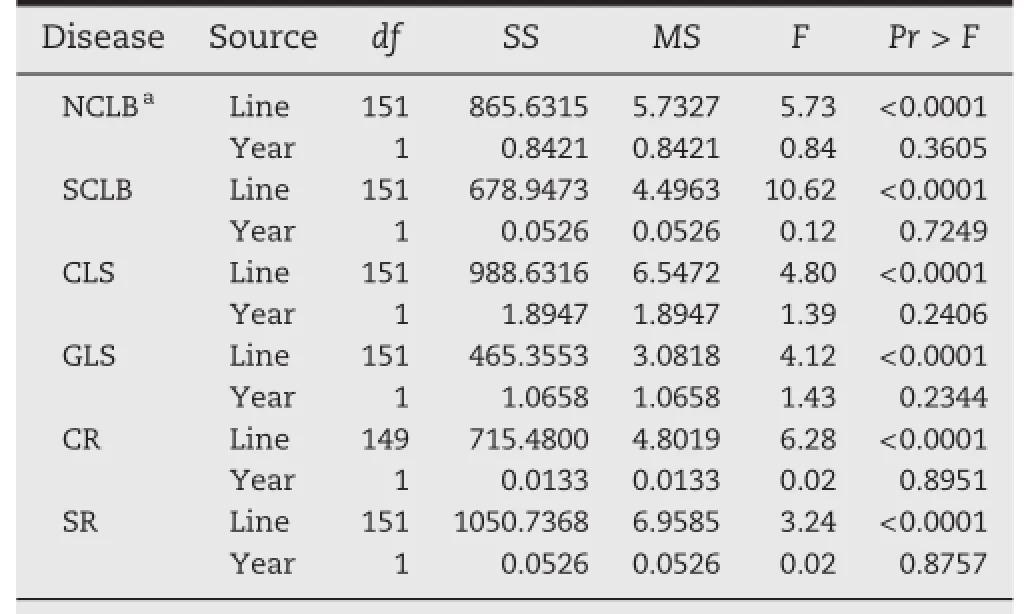
Table 1-Analysis of variance of 152 maize inbred lines.
The first screen for resistance to NCLB,SCLB,CLS,GLS, and common rust was conducted in 2003 and 2004 for 106 and 46 lines,respectively,and was repeated from 2004 to 2005. Reactions to southern rust were evaluated in 2004 and repeated in 2005.
2.2.1.Assessment of resistance to northern corn leaf blight
Seeds were planted on the farmof the Heilongjiang Academy of Agricultural Sciences(HAAS),Harbin,Heilongjiang province, China.The inbred lines Mo 17 and Huobaiwere used as resistant and susceptible controls,respectively.Race 1 of E.turcicum was amplified on sorghum(Sorghum bicolor[L.]Moench)grain medium[22]at 23-25°C in the dark to promote sporulation. Spores were suspended in distilled water at concentrations of 1×105mL-1to 1×106mL-1before inoculation.At growth stage V10[23],inoculation was performed by spraying approximately 10 mL of spore suspension onto the leaf surfaces of each plant.
2.2.2.Evaluation of reactions to southern corn leaf blight and Curvularia leaf spot
Seeds of each line were grown on the experimental farm of the Institute of Crop Science,CAAS,Beijing,China.Lines Mo 17 and Luo 31 were used as resistant and susceptible controls for assessment of SCLB reactions,and Shen 137 and Huangzaosi were grown as resistant and susceptible controls for evaluation of reactions to CLS.Sporulation of isolate O [XB(BJ)-02]of B.maydis and isolate WB(BJ)-95-1 of C.lunata was induced on sorghum grain medium.Inocula were prepared by suspending spores of B.maydis and C.lunata atconcentrations of 1×105to 1×106mL-1and 1×104to 1×105mL-1,respectively. Plants at growth stage V10 were separately inoculated with approximately 10 mL of each inoculum.
2.2.3.Assessment of reactions against gray leaf spot
Seeds of each line were grown at the experimental station of Liaoning Academy of Agricultural Sciences(LAAS),Shenyang, Liaoning province,China.The susceptible line Dan 340 and the highly susceptible line Huobai were grown as susceptible controls.The culture of C.zeae-maydis,which was isolated from infected leaves in Shenyang,was incubated on maize leaf powder plus CaCO3agar(MLPCA)medium[24]to promote sporulation.Spores were washed out with distilled water containing 0.1%Tween-20 and suspended at a concentration of 2.5×103mL-1for inoculation.At growth stages V9 to V11, inoculation was performed by perfusion of approximately 10 mL inoculum into the whorlof centralleaves from the tops of plants using a high-pressure injection apparatus equipped with a 20-mL container without pinhead.
2.2.4.Evaluation of reactions to common rust
Sixty seeds of each line were planted in 2 rows 5 m long at the LAAS experimentalstation.Lines Qi 319 and Huangzaosiwere grown as resistant and susceptible controls,respectively.In spring prior to inoculation,urediospores of P.sorghi,which had been collected from the infected leaves in the preceding year and maintained in a sealed container at-20°C,were incubated in a container with high humidity for 2-4 h at 20-25°C and then suspended in distilled water containing 0.1%Tween-20 at a concentration of 5×104mL-1.Spore suspension was sprayed on the leaves of each plant at growth stages V6 to V8.The inoculation was repeated 10 d after the first inoculation.
2.2.5.Assessment of responses to southern rust
Reactions to southern rust were recorded under natural infection conditions by growing the lines at Sanya,Hainan province,China,where the disease is prevalent each year.Forty plants ofeach line were grown in a 2-row plot 3 m long.Disease severity was recorded at growth stage R5 at the end of February each year when the disease occurred severe[25].
2.3.Experimental designs and rating
Each test ofdisease reactions of alllines was performed in two consecutive years in the same location.Twenty plants of each line were grown in a single row 5.0 m long,0.7 m apart unless otherwise stated.Given that yield loss due to foliar diseases is associated with the areas of lesions on the leaf surface, assessment of reactions to each disease was performed by separating plants into different categories based on the three leaves above and below ears(functional leaves for grain growth).At grain filling stages(R5 to R6),the severity of each disease was rated based on the percentage of lesion areas on leaves,where 1(highly resistant,HR)denotes no lesions or only scattered lesions,covering less than 5%of leaf area;3 (resistant,R)denotes a few lesions on leaves,covering 6%to 10%of leaf area;5(moderately resistant,MR)denotes more lesions on leaves,covering 11%to 30%ofleafarea;7(susceptible, S)denotes large coalesced lesions covering 31%to 70%of leaf area;and 9(highly susceptible,HS)denotes extensive,large, coalesced lesions covering almost the entire leaves,with many leaves dead[22,24,26].
3.Results
3.1.Analysis of reaction and scores in two years of replication
An average score of resistance of all lines to NCLB,SCLB,CLS, GLS,common rust,and southern rust was calculated,respectively,for each year.For each disease the average score between the two years was insignificantly different(Table 1).
3.2.Reactions of the inbred lines to the foliar diseases
A wide range of reactions to NCLB,SCLB,CLS,GLS,common rust,and southern rust was observed in the 152 inbred lines tested(Table 2).The proportions of lines that showed HR,R,or MR reactions to inoculation of different pathogens varied (Fig.1).The percentage of lines resistant to NCLB was 53.3%, but all of them exhibited resistant or moderately resistant reactions and none was highly resistant.Most lines that were resistant to SCLB showed a moderately resistant reaction. Two lines,P138 and D Huang 212,were resistant with an IT of 3.None of the lines was highly resistant to SCLB(Fig.1).The majority of lines(97.4%)were susceptible or highly susceptibleto CLS.Only 4 lines,Shen 137,Qi 318,77,and Nan 60-1, displayed a MR reaction.The percentage of lines that exhibited R or MR reactions to GLS was 14.4%.Approximately 85%of the lines were susceptible to GLS.Although the proportion of lines resistant to common rust was 80.7%,only two lines(i.e.,CS 339 and Ji 412)showed an HR reaction.Most lines(90.8%)were susceptible to southern rust.Lines C8605-2,Qi 319,Shen 136, Dan 3130,and Jinhuang 55 were highly resistant to southern rust.Lines OH 43,X178,Qi318,Za C546,8065,81565,313,CAL99, and B 151 were resistant or moderately resistant to southern rust.
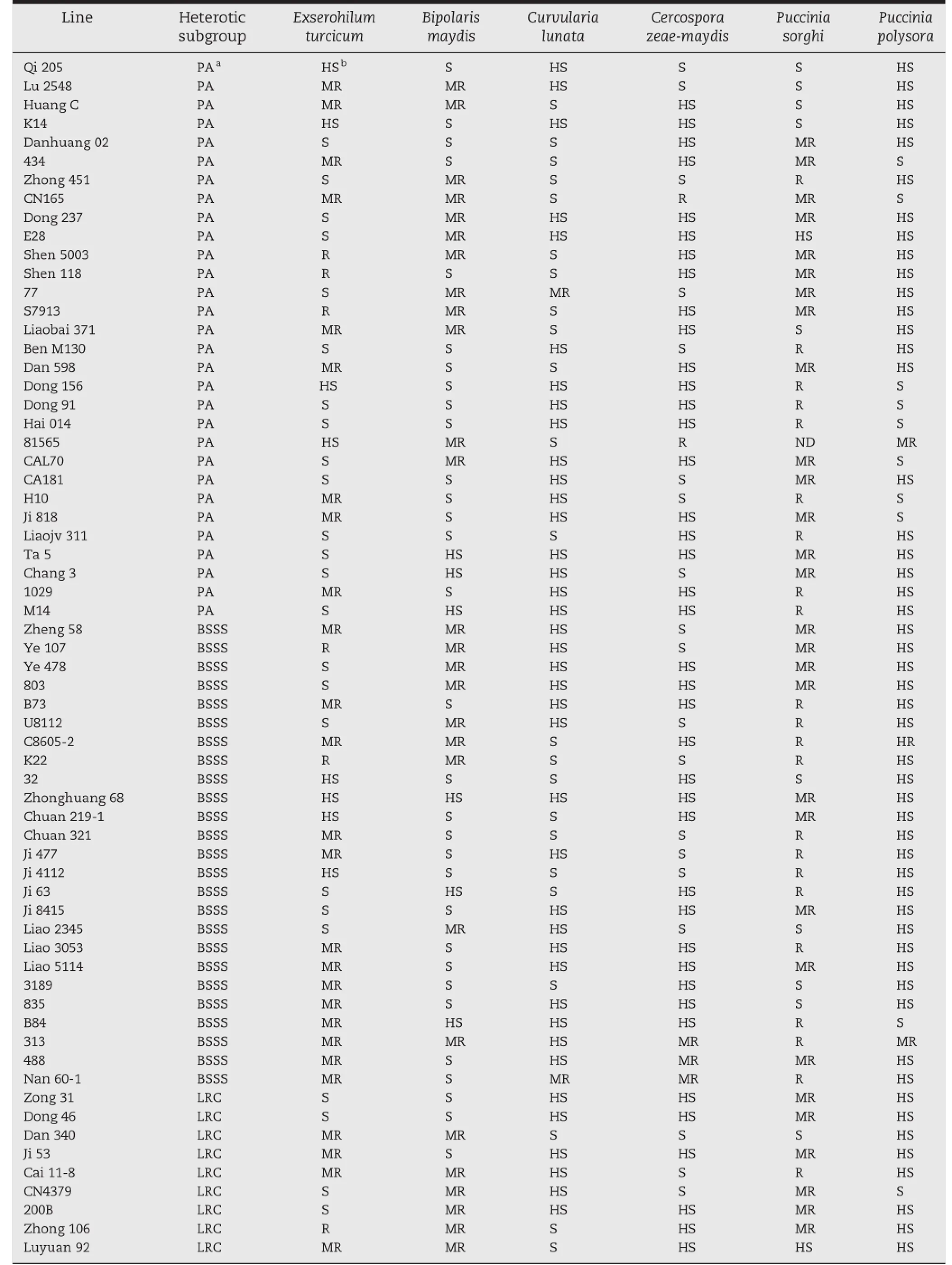
Table 2-Reactions of 152 inbred lines to foliar diseases in maize.

Table 2(continued)
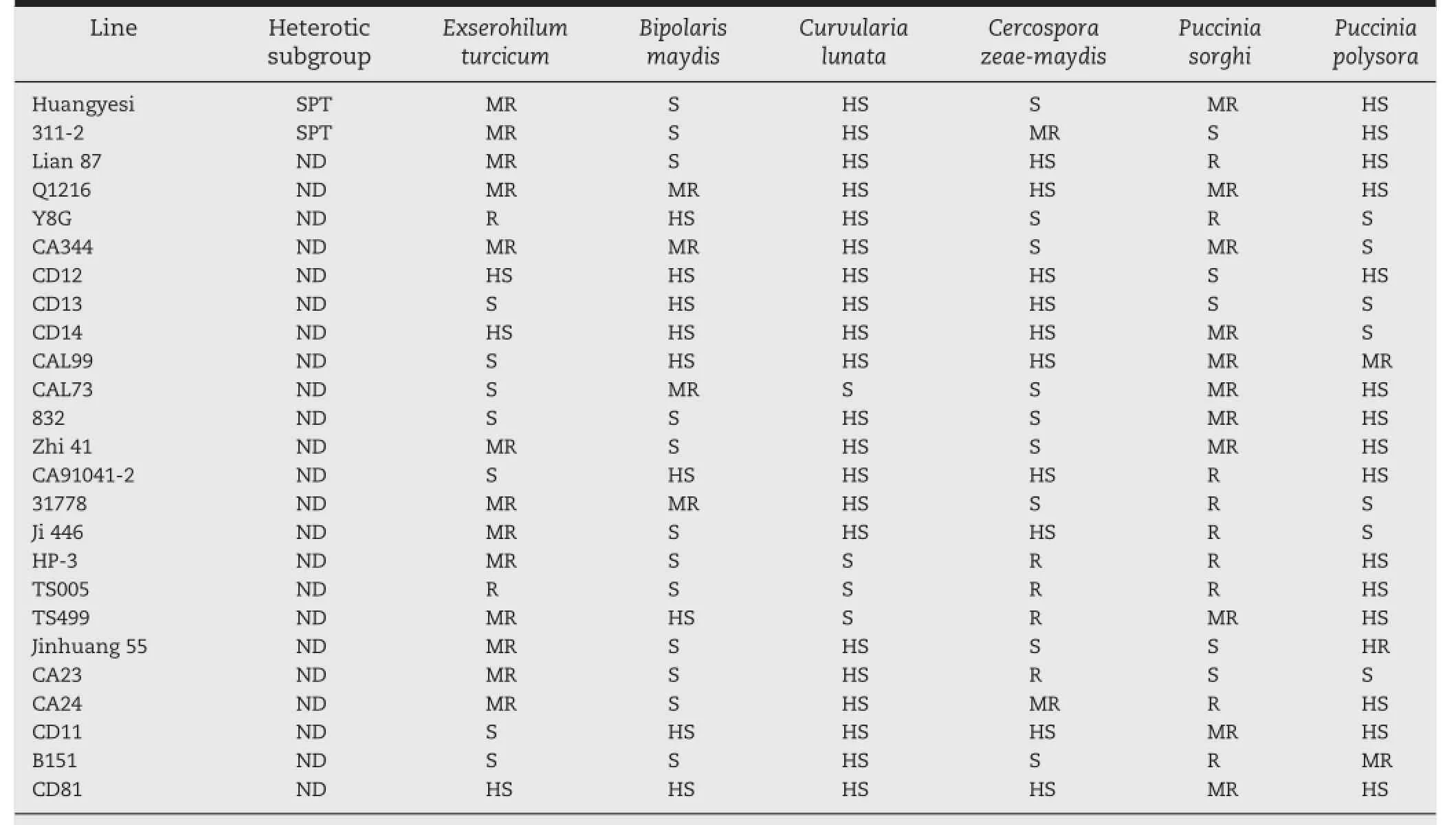
Table 2(continued)
3.3.Multiple resistance of inbred lines to different diseases
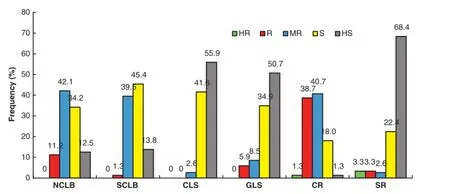
Fig.1-Frequencies of maize inbred lines with highly resistant(HR),resistant(R),moderately resistant(MR),susceptible(S),and highly susceptible(HS)reactions to northern corn leaf blight(NCLB),southern corn leaf blight(SCLB),Curvularialeaf spot(CLS), gray leaf spot(GLS),common rust(CR),and southern rust(SR).
A small percentage of lines was resistant to several diseases simultaneously.Four lines Shen 137,Qi 318,Qi 319,and 313were resistant to 5 diseases tested.Lines Shen 136,Zhongzi 01,Dan 9046,CN165,Chang 7-2,8065,Nan 60-1,and C8605-2 were resistant to 4 diseases.Most of these multiple-diseaseresistant lines were derived from the U.S.hybrids,except for Chang 7-2,which falls into the heterotic group SPT,based on pedigree information(Table 3)[27-32].These lines had been used in developing commercial hybrids widely used in maize production.Approximately 60%of the lines tested were resistant to 2 or 3 diseases.
3.4.Disease reactions of lines in different heterotic subgroups
The percentages of lines resistant to NCLBin different heterotic subgroups ranged from 41.4%to 63.2%.Over 50%of the lines in subgroups BSSS,LRC,PB,Lan,and SPT were resistant to NCLB (Fig.2).Subgroup SPT consisted of 70%lines resistant to SCLB, which included Huangzaosiand Chang 7-2,the most important parentallines in many popular hybrids throughout the country. About 60%of the lines in subgroup PB were resistant to SCLB. Subgroup Lan had smaller percentage(23.5%)of resistant lines than other heterotic subgroups.None of the lines in groups LRC and SPTwas resistantto CLS.Resistance to CLS in otherheterotic subgroups was rare with the highest percentage of 11.8%in subgroup PB.The lines in subgroup PB contained the highest frequency of resistant lines against GLS(47.1%).Lines CN165, 81565,Qi 319,Dan 9046,and 141,which belong to subgroup PA or PB,were resistant to GLS.Another 5 lines(i.e.,HP-3,TS005, TS499,CA23,and CA24)withoutknown information on heterotic subgroups also were resistant to GLS.The percentages of lines resistant to CLS were small in other heterotic subgroups and no resistant line was observed in subgroups Lan and SPT.Similarly, resistance to southern rust occurred in fewer than one fourth of the lines in each heterotic subgroup,except for subgroup PB (52.9%).Most lines in each heterotic subgroup were resistant to common rust,but not to other diseases,with frequencies ranging from 65.0%to 93.8%(Fig.2).
Among the six heterotic subgroups,PB lines showed the higher resistance than other subgroups to the foliar diseases tested, especially to CLS,GLS,and southern rust.Of the 12 lines with resistance to 4 or 5 diseases,6 belonged to subgroup PB(Fig.3).
4.Discussion
Foliar diseases are epidemic not only in China,but also in a wide range of corn production regions in the world,for example,NCLB in Brazil[33]and the U.S.[34,35];SCLB in the U.S.[36];GLS in sub-Saharan Africa[37],Kenya[38],and theU.S.[39];common rust in Kenya[40]and the U.S.[40,41];and southern rust in the U.S.[41,42].These diseases have caused severe economic losses worldwide.
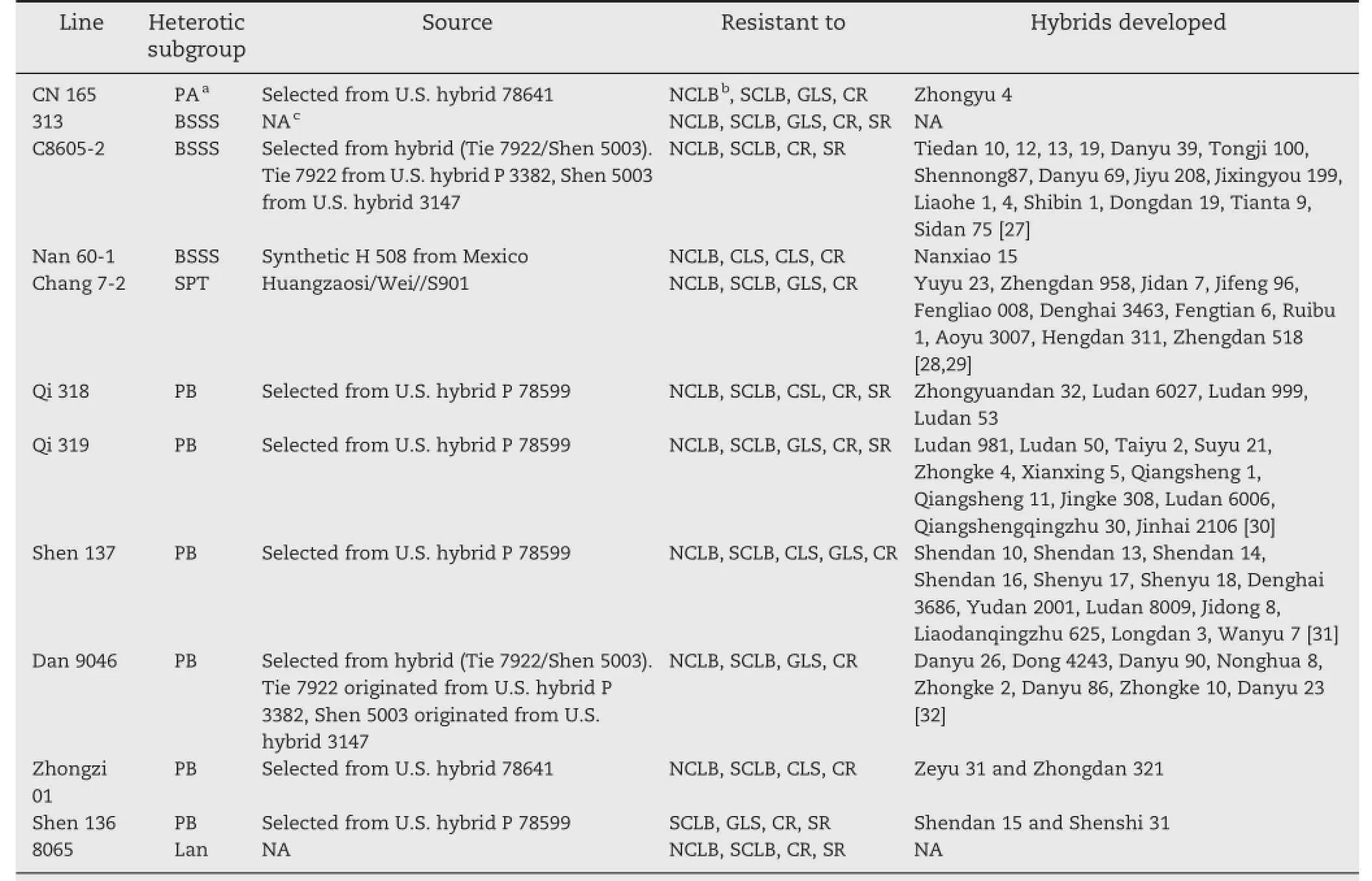
Table 3-Genetic group and pedigrees of 12 inbred lines resistant to multiple foliar diseases.
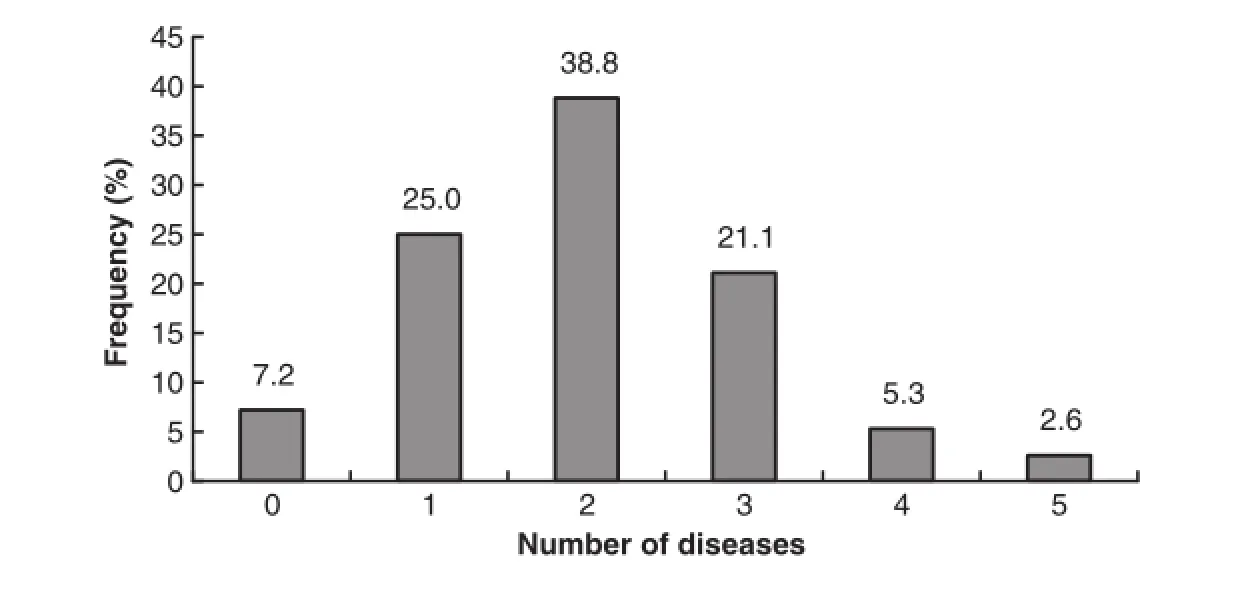
Fig.2-Frequency of maize inbred lines with resistance to different diseases.
Variation in reaction to differentfoliar diseases in maize was detected in major parental lines currently used in commercial hybrids in China.A small number of lines displayed a highly resistant reaction to each disease.The majority of lines in the resistant categories had disease severity rating score of 3(R)or 5 (MR).In particular,none of the lines was highly resistant to NCLB,SCLB,CLS,and GLS.Resistance of a line against 4 to 5 foliar diseases occurred in 7.9%ofthe lines tested.Based on their pedigrees,most of themwere derived from the U.S.germplasm. Lines belonging to different heterotic subgroups exhibited variation in their reactions to the diseases examined.Lines in subgroup PB contained greater percentages of lines resistant to various diseases,especially to GLS,CLS,andsouthern rust.Six of the twelve lines with resistance to 4 or 5 diseases belong to subgroup PB.Lines in subgroup SPT displayed a high frequencyof resistance to SCLB.Subgroup SPT consists of some important inbred lines,such as Chang 7-2.This line was resistant to NCLB, SCLB,GLS,and common rust,butsusceptible to CLS and southern rust.Line Chang 7-2 is the maternal parent of the hybrid Zhengdan 958,which is the largest variety covering 450 million hectares in China.This line was also involved in development of a number of widely grown varieties(Table 3)[29].Most lines in each heterotic subgroup were resistant to common rust,but a few were resistant to CLS.The frequency of lines resistant to GLS and southern rust was also low in most subgroups except for PB containing approximately 50%of resistant lines.
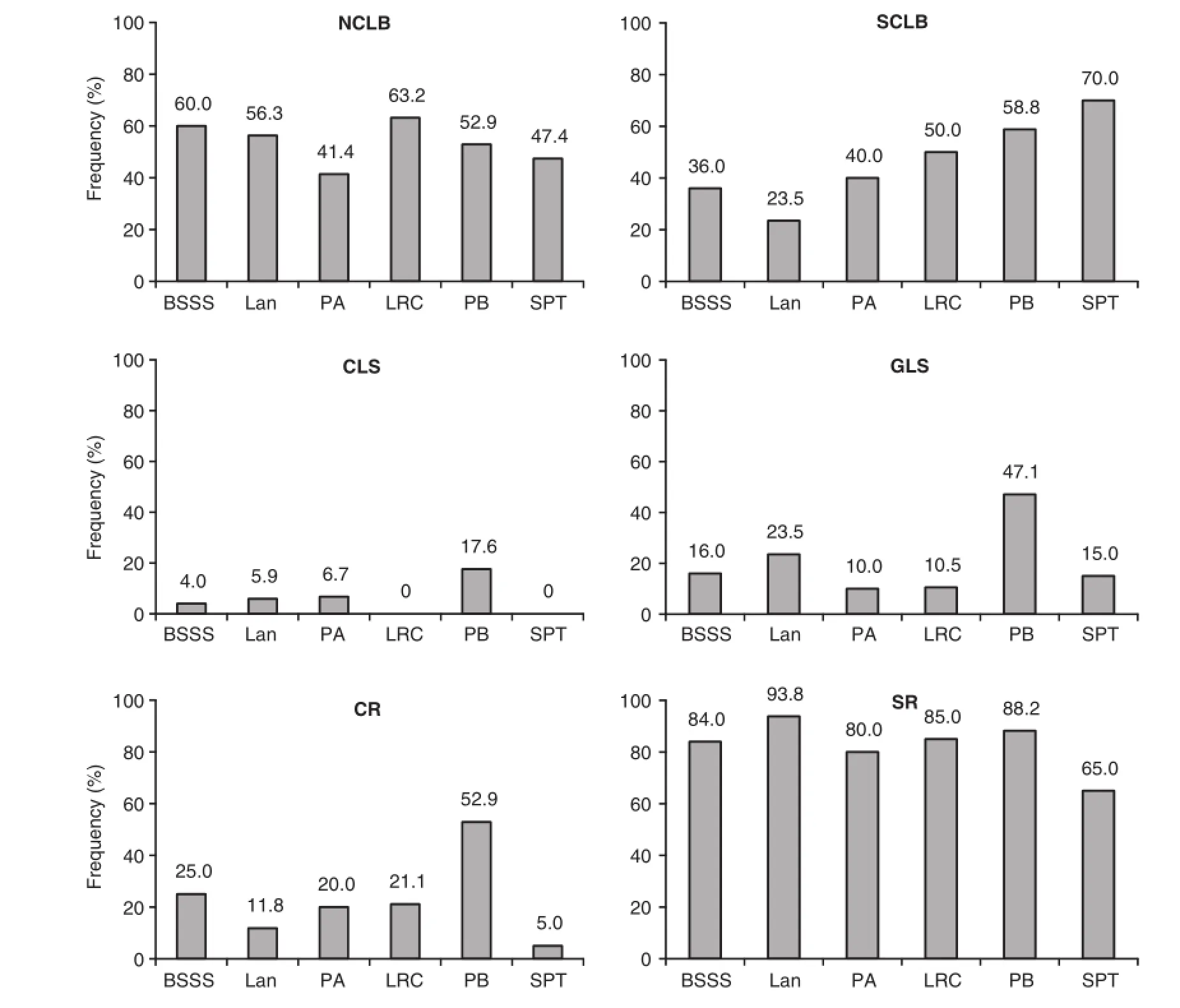
Fig.3-Frequencies of maize inbred lines in different heterotic subgroups with resistance to northern corn leaf blight(NCLB), southern corn leaf blight(SCLB),Curvularialeaf spot(CLS),gray leaf spot(GLS),common rust(CR),and southern rust(SR).
Northern corn leaf blight and southern corn leaf blight are the most important diseases in the spring and summer maize producing regions,respectively.These diseases have been well controlled by growing resistant cultivars[43].However,more than 10 E.turcicum races have been detected in the northeastern and northern China spring maize regions,some of which can overcome the four known resistance genes[44-49].Although half of the lines tested in the present study were resistant or moderately resistant to NCLB,identification of resistant lines with different Ht genes for resistance to NCLB and/or gene combinations using different races is desirable.This measure will facilitate the sustainable use of resistance to NCLB in the field.Field investigation has demonstrated that strains with high pathogenicity occur in race O of B.maydis,producing larger lesions and severe leaf necrosis[50].Thus,deployment of inbred lines resistant to epidemic and high pathogenic strains of B.maydis is an important task in developing inbred lines against SCLB.
The increasing importance of CLS and GLS in certain regions has required resistant parental lines.The results from the present study reveala shortage oflines highly resistant to these diseases in the pool of inbred lines currently used in maize hybrid production.This situation renders commercial maize hybrids vulnerable to epidemics of CLS and GLS.There is an urgent need to deploy lines with high resistance to these diseases.Unfortunately,none of the lines was resistant to CLS, except for a few lines with moderate resistance.Only nine lines were resistant to GLS.Given that resistance to CLS and GLS was controlled by multigenes in a quantitative trait locus model [34,51-53],it is not easy to find high level of resistance to these diseases.A broad range of germplasm lines from various sources should be screened to identify lines that are highly resistant to CLS and GLS.
Common rustwas wellcontrolled,with most lines displaying sufficient resistance.However,highly resistant lines are also needed in southwestern provinces of China,owing to severe epidemics of the disease.Compared to common rust,the proportion of lines resistant to southern rust was small,and additional work is needed to identify highly resistant germplasm lines.These are of particular importance in summer maize breeding programs.
Acknowledgments
The authors thank Dr.D.Jeffers of CIMMYT for providing the protocols of disease resistant tests.Financial support provided by the Ministry of Agriculture of China(No.2003-Q03)is gratefully appreciated.
R E F E R E N C E S
[1]J.C.Wu,G.Chen,G.Z.Zou,T.Y.Zhang,C.T.Liu,Y.X.Xu, Preliminary study on race of Exserohilum turcicum on maize, Acta Phytopathol.Sin.13(1983)15-20(in Chinese with English abstract).
[2]G.Chen,Distribution and control of Exserohilum turcicum race 2,J.Maize Sci.1(1993)65-66(in Chinese with English abstract).
[3]C.X.Li,J.Su,S.C.Gong,X.Z.Song,S.Q.Yan,G.L.Li,G.H.Hu, Study on the change of physiological form of the northern leaf blight in Heilongjiang Province,Heilongjiang Agric.Sci.1 (2004)16-18(in Chinese with English abstract).
[4]L.X.Kong,J.Y.Zhao,Q.S.Li,L.S.Wang,P.C.Luo,Identification and population dynamics of physiological races of Bipolaris maydis in Hebei,Acta Agric.Boreali-Sin.20(2005)90-93(in Chinese with English abstract).
[5]G.Z.Lu,Z.H.Liu,F.G.He,Q.Zhao,W.R.Liu,Y.K.Song,J.S.He, M.Z.Jiang,H.C.Zhao,Break of new disease,Curvularia leaf spot,in Liaoning province,J.Shenyang Agric.Univ.28(1997) 75-76(in Chinese with English abstract).
[6]F.C.Dai,X.M.Wang,Z.D.Zhu,W.D.Gao,N.X.Huo,X.H.Jin, Curvularia leafspotofmaize:pathogens and varietalresistance, Acta Phytopathol.Sin.28(1998)123-129(in Chinese with English abstract).
[7]J.T.Li,J.F.Fu,X.R.Yan,H.C.Li,R.J.Zhou,Analysis oftemporal dynamics of Curvularia leaf spot of maize(Curvularia lunata) epidemic and yield loss,J.Shenyang Agric.Univ.37(2006) 835-839(in Chinese with English abstract).
[8]Z.G.Gao,J.Chen,C.S.Xue,H.L.Guo,H.H.Yan,G.Q.Wang,B. Fu,G.Chen,Z.Y.Wang,L.Chen,J.G.Shi,Study on incidence,regularity of epidemiology and inducing condition of gray leaf spot in maize,J.Shenyang Agric.Univ. 31(2000)460-464(in Chinese with English abstract).
[9]G.Z.Lu,Y.X.Zhang,J.Y.Liang,H.Yang,G.Chen,Y.Sun,L. Chen,Z.Y.Wang,Epidemics of gray leaf spot of corn (Cercospora zeae-maydis)and varietal resistance,Acta Phytopathol.Sin.33(2003)462-467(in Chinese with English abstract).
[10]Z.Y.Li,L.Y.Mei,Study on investigation of gray leaf spot of maize in Heilongjiang Province,Heilongjiang Agric.Sci.5 (2008)72-74(in Chinese with English abstract).
[11]Z.Z.Lu,Y.J.Li,H.C.Li,J.F.Fu,Studies on effect ofgray leafspot to yield loss and yield characters,J.Maize Sci.16(2008) 126-129(in Chinese with English abstract).
[12]Z.H.Ren,Q.F.Su,L.M.Meng,H.Li,S.Y.Song,Z.W.Zhao,H.Y. Pan,Q.M.Jin,RAPD analysis of Cercospora zeae-maydis in Jilin province,J.Maize Sci.19(2011)118-121(in Chinese with English abstract).
[13]X.Li,X.F.Zhang,L.N.Cui,C.J.Zou,Y.M.Yang,Y.Lin,J.K. Zhang,Q.F.Shu,Attention to the epidemic ofgray leaf spot of maize in Sichuan Province,Sichuan Agric.Sci.Tech.12(2011) 37(in Chinese with English abstract).
[14]H.P.Zhou,J.Z.Wu,Y.Q.Li,W.H.Zhao,W.X.Xiao,Y.X.Wu,Y. Q.He,Epidemic of gray leaf spot of maize in Yunnan province,southwest China,J.Agric.Sci.24(2011)2207-2211.
[15]D.van Inghelandt,A.E.Melchinger,J.P.Martinant,B.Stich, Genome-wide association mapping of flowering time and northern corn leaf blight(Setosphaeria turcica)resistance in a vast commercialmaize germplasm set,BMC Plant Biol.12 (2012)56-70.
[16]F.Technow,A.Bürger,A.E.Melchinger,Genomic prediction of northern corn leaf blight resistance in maize with combined or separated training sets for heterotic groups,G3: Genes/Genomes/Genet.3(2013)197-203.
[17]F.Tian,P.J.Bradbury,P.J.Brown,H.Y.Hung,Q.Sun,S. Flint-Garcia,T.R.Rocheford,M.D.McMullen,J.B.Holland,E.S. Buckler,Genome-wide association study of leaf architecturein the maize nested association mapping population,Nat. Genet.43(2011)163-168.
[18]M.N.Barakat,A.A.El-Shafei,A.A.Al-Doss,Identification of molecular markers linked to northern corn leaf blight resistance in yellow population of maize,G3: Genes/Genomes/Genet.3(2009)89-95.
[19]C.X.Xie,S.H.Zhang,M.S.Li,X.H.Li,Z.F.Hao,L.Bai,D.G. Zhang,Y.H.Liang,Inferring genome ancestry and estimating molecular relatedness among 187 Chinese maize inbred lines,J.Genet.Genomics 34(2007)738-748.
[20]X.H.Li,L.X.Yuan,S.H.Zhang,M.S.Li,W.H.Li,Heterotic grouping of 70 maize inbred lines by SSR makers,Sci.Agric. Sin.36(2003)622-627(in Chinese with English abstract).
[21]M.J.Xiao,M.S.Li,Y.W.Sun,X.H.Li,S.H.Zhang,Genetic diversity revealed by SSR among maize inbred lines used predominantly in Liaoning Province,J.Maize Sci.14(2006) 33-36(in Chinese with English abstract).
[22]Agriculture Standard in P.R.China NY/T 1248.1-2006,Rules for Evaluation of Maize for Resistance to Pests,China Agricultural Press,Beijing,2007.
[23]S.W.Ritchie,J.J.Hanway,G.O.Benson,How a Corn Plant Develops,Special Report No 48,Iowa State University of Science and Technology,Cooperative Extension Service, Ames,Iowa,1992.
[24]X.D.Xu,H.Y.Dong,Y.Jiang,Z.H.Liu,The technique for identification of resistance to gray leaf spot on maize,Acta Phytopathol.Sin.30(2003)129-132(in Chinese with English abstract).
[25]X.M.Wang,Techniques for identification and investigation of maize resistance to diseases and insect pests,Crops 109 (2005)53-55(in Chinese).
[26]X.M.Wang,F.C.Dai,Q.Liao,S.X.Sun,Handbook of Maize Disease and Insect Pests,China Agricultural Science-Technology Press,Beijing,2002.(in Chinese).
[27]X.D.Yu,M.H.Xu,R.H.Jiao,Application of elite maize inbred line C8605-2 in germplasm improvement and development,J. Maize Sci.15(2007)36-38(in Chinese with English abstract).
[28]W.Y.Zhang,F.P.Hua,W.M.Shen,J.P.Wang,G.T.Zhang,D.B. Wang,The cultivation and popularization of a fine maize inbred line Chang 7-2,J.Henan Inst.Sci.Technol.(Nat.Sci. Edn.)29(2001)17-19(in Chinese with English abstract).
[29]L.M.Zheng,Y.F.Niu,F.Bai,J.M.Cui,Z.Q.Pei,Z.P.Liu,Keeping purity and improvement on maize inbred line Chang 7-2,China Seed Ind.6(2007)48-49(in Chinese with English abstract).
[30]C.Ma,J.L.Chen,B.Su,W.Hou,B.L.Yan,Breeding and utilization of a maize cytoplasmic sterile line-“C Qi319”,China Seed Ind. 6(2002)23-24(in Chinese with English abstract).
[31]H.J.Zhang,Y.Z.Liu,H.B.Zhang,Z.P.Zhang,Breeding and its application of excellent maize inbred line Shen 137,J.Maize Sci.14(2006)58-59(in Chinese with English abstract).
[32]G.Z.Guan,The breeding and utilization of cytoplasm sterile maize inbred line C-Dan 9046,J.Liaoning Agric.Vocat.Tech. Coll.5(2003)18-20(in Chinese with English abstract).
[33]M.C.F.Esteves,Reações a Exserohilum turcicum(Pass.)Leonard &Suggs em milho(Zea mays L.)e variabilidade do patógeno, (Master’s Thesis)Universidade de São Paulo,Escola Superior de Agricultura“Luiz de Queiróz”,Piracicaba,1989.
[34]J.M.Perkins,W.L.Pedersen,Disease development and yield losses associated with northern leaf blight of corn,Plant Dis. 71(1987)940-943.
[35]J.P.Krausz,Epidemic of northern corn leaf blight in Texas in 1992,Plant Dis.77(1993)1063.
[36]L.A.Tatum,The southern corn leaf blight epidemic,Science 171(1971)1113-1116.
[37]J.M.J.Ward,E.L.Stromberg,D.C.Nowell,F.W.Nutter Jr.,Gray leaf spot:a disease of global importance in maize production, Plant Dis.83(1999)884-895.
[38]J.Danson,M.Lagat,M.Kimani,A.Kuria,Quantitative trait loci(QTLs)for resistance to gray leaf spot and common rust diseases of maize,Afr.J.Biotechnol.7(2008)3247-3254.
[39]P.W.Crous,U.Braun,Mycosphaerella and its anamorphs:1 Names published in Cercospora and Passalora,CBS Biodivers. Ser.1(2003)1-571.
[40]D.A.Shah,H.R.Dillard,Yield loss in sweet corn caused by Puccinia sorghi:a meta-analysis,Plant Dis.90(2006)1413-1418.
[41]H.R.Dillard,R.C.Seem,Use of an action threshold for common maize rust to reduce crop loss in sweet corn, Phytopathology 80(1990)846-849.
[42]R.Rodriguez-Ardon,G.E.Scott,S.B.King,Maize yield losses caused by southern corn rust,Crop Sci.20(1980)812-814.
[43]X.M.Wang,Q.M.Jin,J.Shi,Z.Y.Wang,X.Li,The status of maize diseases and the possible effect of variety resistance on disease occurrence in the future,Acta Phytopathol.Sin.36 (2006)1-11(in Chinese with English abstract).
[44]X.M.Gui,J.G.Dong,X.Q.Hou,Identification of physiological race of Setosphaeria turcica in China in 2001,J.Agric.Univ. Hebei 26(2003)11-13(in Chinese with English abstract).
[45]S.Q.Sun,L.L.Wen,J.G.Dong,Identification of physiological races and mating type of Exserohilum turcicum,J.Maize Sci.13 (2005)112-113(in Chinese with English abstract).
[46]Y.P.Wang,X.M.Wang,Q.Ma,Races of Exserohilum turcicum, causal agent of northern leaf blight in China,J.Maize Sci.15 (2007)123-126(in Chinese with English abstract).
[47]H.Zhao,Z.G.Gao,X.F.Zhang,J.H.Zhuang,H.Sui,Population of physiological races of Setosphaeria turcica and its dynamic analysis in China,J.Shenyang Agric.Univ.39(2008)551-555 (in Chinese with English abstract).
[48]J.X.Gao,S.X.Lu,Z.G.Gao,J.H.Zhuang,X.F.Zhang,S.Zhang, Identification and dynamic analysis of physiological race of Exserohilum turcicum in Northeastern China in 2009,J. Maize Sci.19(2011)138-140(in Chinese with English abstract).
[49]L.Z.Wang,Z.Y.Kang,J.Z.Wu,Y.X.Wu,Z.C.Mao,Y.Q.He, Identification of physiologicalraces and analysis of mating type of Setosphaeria turcica in Yunnan province,J.Huazhong Agric.Univ.30(2011)187-192(in Chinese with English abstract).
[50]J.Shi,Z.Y.Wang,K.L.He,Changes and occurrence trend of corn diseases and insect pests in Huang-Huai-Hai summer corn regions,Plant Protect.31(2005)63-65.
[51]A.Lehmensiek,A.M.Esterhuizen,D.van Staden,S.W.Nelson, A.E.Retief,Genetic mapping of gray leaf spot(GLS)resistance genes in maize,Theor.Appl.Genet.103(2001)797-803.
[52]Y.Li,F.C.Dai,R.L.Jin,T.Y.Wang,J.Y.Du,J.Z.Jia,QTL analysis of resistance to Curvularia lunata in maize,Sci.Agric.Sin.35 (2002)1221-1227(in Chinese with English abstract).
[53]L.Y.Shi,X.H.Li,Z.F.Hao,C.X.Xie,H.L.Ji,X.L.Lu,S.H.Zhang, G.T.Pan,Comparative QTL mapping of resistance to gray leaf spot in maize based on bioinformatics,Agric.Sci.China 6 (2007)1411-1419
*Corresponding author.
E-mail address:wangxiaoming@caas.cn(X.Wang).
Peer review under responsibility of Crop Science Society of China and Institute of Crop Science,CAAS.
Screening
Resistance
Fungaldiseases
杂志排行
The Crop Journal的其它文章
- Brief Guide for Authors
- Genome-wide analysis and identification of cytokinin oxidase/dehydrogenase(CKX)gene family in foxtail millet(Setaria italica)
- Optimal yield-related attributes of irrigated rice for high yield potentialbased on path analysis and stability analysis
- Effect of different levels of nitrogen deficiency on switchgrass seedling growth
- Effects of free-air CO2enrichment on adventitious root development of rice under low and normal soil nitrogen levels
- Effect of stripe rust on the yield response of wheat to nitrogen
